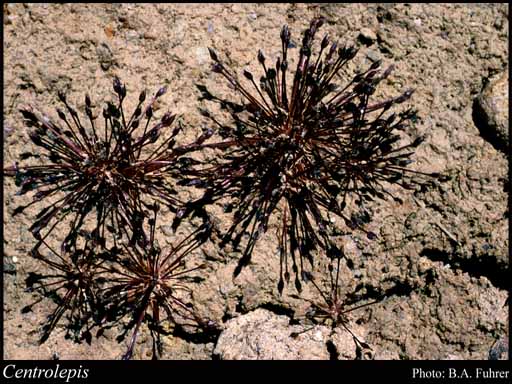- Reference
- Nov.Holl.Pl. 1:7, t. 1. (1805)
- Name Status
- Current

Scientific Description
Family Centrolepidaceae.
Habit and leaf form. Herbs. Annual, or perennial; plants with a basal concentration of leaves (when annual), or with neither basal nor terminal concentrations of leaves; with fibrous root system. Leaves alternate; spiral; sessile; sheathing. Leaf sheaths with free margins. Leaves simple. Leaf blades entire; linear (to subulate); 1 -nerved; parallel-veined. Leaves ligulate, or eligulate; with a persistent basal meristem, and basipetal development. Vegetative anatomy. Plants with silica bodies, or without silica bodies. Leaf anatomy. Leaf blade epidermis without differentiation into ‘long’ and ‘short’ cells. Guard-cells ‘grass type’. Stem anatomy. Secondary thickening absent.
Reproductive type, pollination. Fertile flowers functionally male and functionally female. Unisexual flowers present. Plants monoecious. The unisexual flowers not conspicuously in separate aggregates. Female flowers aggregated in ‘inflorescences’ (the carpels often inserted at different levels and partly united along the stipe and inner part of the ovary). Male flowers without pistillodes. Floral nectaries absent (nectaries absent). Anemophilous.
Inflorescence and flower features. Flowers aggregated in ‘inflorescences’; in ‘spikelets’. The terminal inflorescence unit cymose. Inflorescences scapiflorous; terminal; a cymose head, containing 2–30 pseudanthia; each pseudanthium consisting of 0–1 male and 1–30 fused female flowers; pseudanthial. Flowers bracteate (2 primary bracts enclosing the inflorescence); bracteolate (secondary bracts hyaline or scarious, 2–3 per pseudanthium), or ebracteolate; small. Floral receptacle developing a gynophore. Perianth absent. Fertile stamens present, or absent (from female flowers). Androecium 1 (constituting the male flower, as here interpreted). Androecium exclusively of fertile stamens. Stamens 1. Filaments glabrous; capillary. Anthers dorsifixed; versatile; dehiscing via longitudinal slits; unilocular; bisporangiate. Fertile gynoecium present, or absent (male flower). Gynoecium 1 carpelled (constituting the female flower). The pistil 1 celled. Gynoecium monomerous; of one carpel; superior. Carpel 1 ovuled. Placentation apical. Ovary stipitate. Ovules pendulous; non-arillate; orthotropous.
Fruit and seed features. Fruit non-fleshy. The fruiting carpel dehiscent (each carpel dehiscing by an abaxial slit); a follicle (tiny). Gynoecia of adjoining flowers combining to form a multiple fruit. Dispersal unit the seed. Seeds ovoid to fusiform; copiously endospermic. Endosperm not oily (starchy). Perisperm absent. Seeds with starch. Embryo rudimentary at the time of seed release (minute, obconical). Seedling. Germination epigeal (seed remnant visible on apex of the cotyledon (which appears as the basal leaf)). Hypocotyl internode absent. Mesocotyl absent. Seedling collar not conspicuous. Cotyledon hyperphyll elongated; assimilatory; more or less circular in t.s. Coleoptile absent. Seedling cataphylls absent. First leaf centric. Primary root ephemeral.
Physiology, biochemistry. Aluminium accumulation demonstrated.
Geography, cytology, number of species. Native of Australia. Not endemic to Australia.